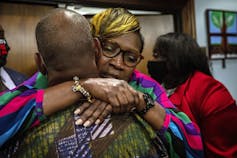By Jasmeet Bahia
This article is republished from The Conversation under a Creative Commons licence. All photos provided by The Conversation from various sources.
Recently, two highly publicized trials came to a close. One involved three white men found guilty of killing Ahmaud Arbery, an unarmed Black man who was attacked and killed while jogging in Brunswick, Ga.
The other case centred around a white 18-year-old named Kyle Rittenhouse. Rittenhouse shot three people during an anti-racism protest. Jurors acquitted him of all charges.
In case you missed the details of this highly polarizing case: Rittenhouse shot and killed two men and injured a third during a protest in Kenosha, Wis., in 2020. The protests were in response to the police shooting of a Black man, Jacob Blake. Rittenhouse claimed his shots were fired in self-defence.
Both trials have brought up questions about race in America, Black lives, whiteness, the future of protest and self-defence. The Rittenhouse case also raises questions about when whiteness protects white people and when it does not.
In the last decade, the American public has witnessed both civilian white men as well as police injuring and killing innocent Black Americans with few consequences. Some extreme cases result in death, but other examples of harassment and violence are abundant.
The harassment of Black people in their daily lives, such as birdwatcher Christian Cooper or Shayne Holland, who was asked to leave his apartment complex swimming pool, is a more quiet, insidious violence.
In the case of Rittenhouse, however, both the accused and the victims were white. Those who are familiar with the American justice system aren’t surprised by the non-guilty verdict. Rittenhouse is added to a long list of white men who have everything stacked in their favour in a court of law.
Rittenhouse had his (white) boyhood and a favourable judge who banned anyone in the court from labelling the shooting victims as victims.
While Rittenhouse is not connected to any white supremacy groups, his lionization by them has given him social and political clout. Former president Donald Trump, FOX News media host Tucker Carlson and other online commentators in far-right chat rooms are applauding Rittenhouse as a “sweet kid” and vigilante.
Who does ‘whiteness’ save?
The acquittal of Rittenhouse and his celebrity among right-wing extremists proves that white skin colour alone is not enough to protect white people. If whiteness is not enacted in service to white supremacists, it is considered a threat to them.
The white victims, Joseph Rosenbaum, Anthony Huber and Gaige Grosskreutz, have been called “race traitors” by the far right, meaning their whiteness stopped shielding them from the violence of other white people.
History is full of examples of this. Abolitionist Elijah Parish Lovejoy, civil rights activist Viola Liuzzo, Heather Heyer — who was protesting the Unite the Right rally in Charlottesville, Va., in 2017 — and the 168 adults and children who died in the Oklahoma City bombing are part of a history of white supremacists killing those they deem unfit for their version of whiteness.
After the civil rights movement, as legal and social repercussions against violence against Black Americans were put in place, white supremacist groups felt that they could not be as openly violent as they had historically been. This pattern of violence — failing to protect white people who take the side of racialized communities — will likely be exacerbated by the Rittenhouse acquittal.
The betrayal of white supremacy by allies is seen as so egregious that any obstacle to the dominance of white people will be removed regardless of the colour of their skin.
Fear of being replaced
We have increasingly seen more violent counter-reactions to the Black Lives Matter movement. Many of those who attend in opposition to the movement are hyper-vigilant about defending what they see as “American values.”
The idea that white men are protecting society from Black peple
has been part of the American narrative since the era of slavery. This fear of being replaced by people of colour persists today and contributes to a sense of fragility.

(AP Photo/Stephen B. Morton)
The protection of white safety is ingrained in western societies, including within our legal systems. The Rittenhouse trial has likely created a sense of safety among right-wing groups as this case establishes historical precedent for their actions to be labelled as self-defence.
While Ahmaud Arbery was killed due to his Blackness, Rittenhouse’s victims shared an identity with their perpetrator. The praise for Rittenhouse, as well as the denouncement of his victims by white extremists, highlights the question of who is safe under white supremacy and who is not.
![]()
Thursday, December 2, 2021 in The Conversation
Share: Twitter, Facebook



